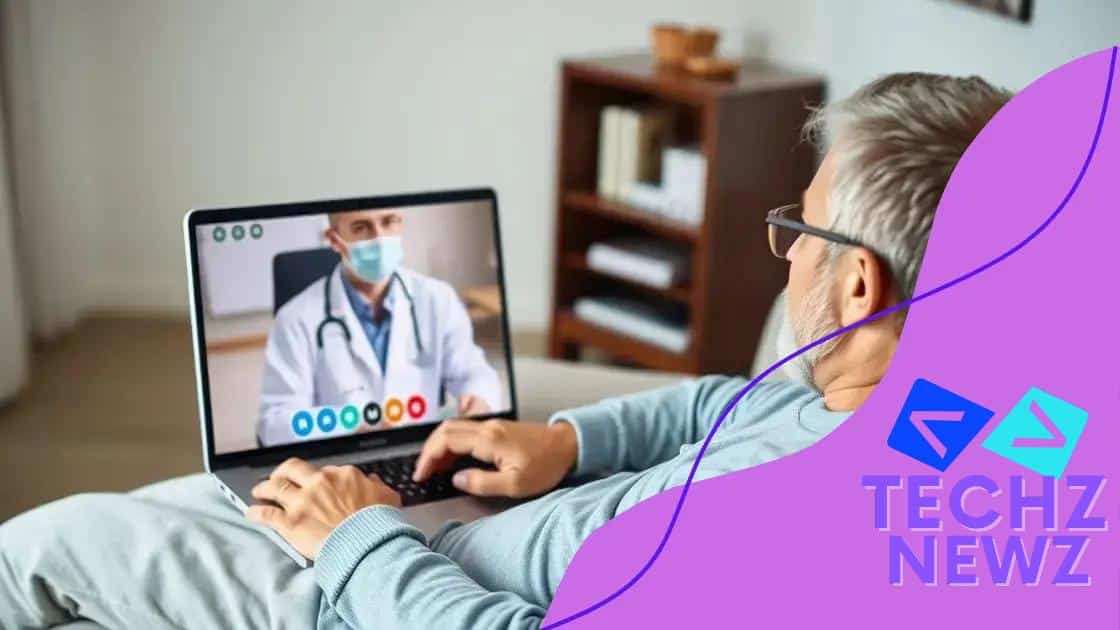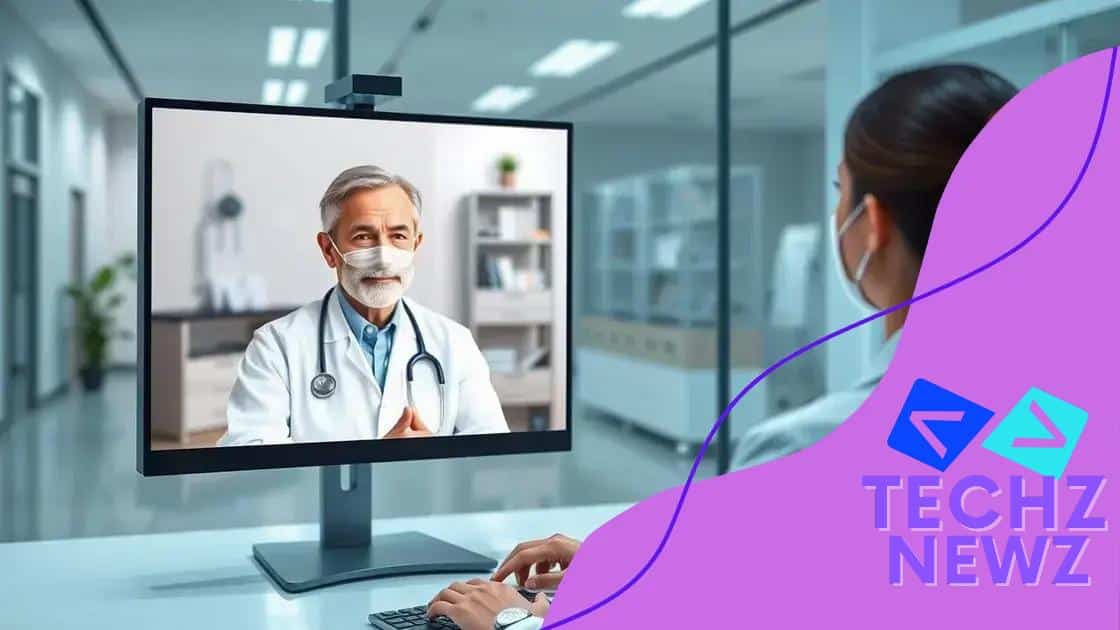How telemedicine is reshaping healthcare benefits

Telemedicine is reshaping healthcare benefits by enhancing access to medical care, offering convenience for consultations, and reducing costs, while also facing challenges such as technical barriers and privacy concerns.
How telemedicine is reshaping healthcare benefits is a topic that has garnered significant attention lately. Imagine being able to consult with your doctor from the comfort of your home. This convenience raises important questions about its impact on patient care and healthcare access. Let’s dive into the transformative aspects of telemedicine.
Understanding telemedicine and its evolution
Telemedicine has transformed the way we think about healthcare. With advancements in technology, it’s easier than ever to connect with healthcare providers from anywhere. Understanding how telemedicine has evolved helps us appreciate its impact on patient care.
What is Telemedicine?
Telemedicine refers to using technology to deliver healthcare services remotely. This includes video calls, phone consultations, and even messaging. It makes healthcare more accessible and convenient.
Key Historical Milestones
Telemedicine isn’t as new as you might think. Its history dates back to the 1960s!
- 1960s: Pilot projects using telephone and television for consultations began.
- 1990s: Internet adoption led to more widespread use of telehealth services.
- 2000s: Mobile technology emerged, allowing for more portable solutions.
Today, telemedicine is a key part of healthcare, especially during crises like the COVID-19 pandemic. More people than ever are using telemedicine to get care. The pandemic really spurred its growth, pushing many clinics to adopt these practices.
With telemedicine, many healthcare providers can deliver quality care without needing an in-person visit. Patients can now receive follow-ups, get prescriptions, and even diagnose conditions without stepping outside. This has made managing chronic illnesses much easier.
Benefits of Telemedicine
Telemedicine offers numerous advantages for both patients and healthcare providers.
- Convenience: Patients can connect with doctors anytime, making accessing care much easier.
- Cost-effective: Reduces travel expenses and time off work.
- Increased access: People in remote areas can receive expert care they might not have easily found.
This evolution in healthcare means we can provide better, more efficient care. By using technology, we can bridge gaps in service and reach more patients. As we continue exploring telemedicine, it’s clear its role in healthcare is only going to grow.
Benefits of telemedicine for patients
The rise of telemedicine has brought many benefits for patients. This modern approach makes it easier for individuals to receive quality healthcare without the barriers of distance or transportation. Thanks to advancements in technology, patients can now consult their doctors from the comfort of their own homes.
Improved Access to Care
One of the main benefits of telemedicine is improved access to healthcare services.
- Patients in rural or remote areas can connect with specialists.
- Limited mobility or transportation issues are less of a concern.
- Scheduling appointments becomes more flexible, accommodating busy lifestyles.
Telemedicine allows patients to skip long wait times in a doctor’s office, receiving care more quickly.
Cost-Effectiveness
Another significant advantage of telemedicine is its cost-effectiveness. By eliminating the need for travel, patients save money in several ways.
- Reduced transportation costs to and from appointments.
- Savings on childcare or missed work due to in-person visits.
- Lower overall healthcare costs through preventive care and early treatment.
Receiving care remotely means patients can also avoid additional fees associated with urgent care or emergency room visits.
Convenience and Comfort
With telemedicine, patients enjoy the convenience of accessing medical care from home. This setting often leads to more relaxed and open conversations between doctors and patients.
Technology enables patients to share information quickly and easily. Video calls allow for more personal interactions, while messaging apps allow for quick questions without needing an appointment.
Moreover, patients can follow-up more easily, ensuring they stay on track with their treatment plans. This type of care can lead to improved health outcomes since patients remain engaged and involved in their health journey.
Overall, telemedicine is revolutionizing healthcare for patients by making it more accessible, cost-effective, and convenient. As technology evolves, these benefits will continue to expand.
How telemedicine is changing healthcare delivery

Telemedicine is significantly changing how healthcare is delivered. By using technology, it breaks down barriers that once made getting medical help difficult. Now, more patients can access vital services from anywhere, making healthcare more inclusive.
Accessibility for All
One major way telemedicine changes healthcare delivery is through increased accessibility. Patients who may struggle to travel, such as the elderly or those living in rural areas, can now consult with doctors from home.
- Eliminates long travel times and waiting rooms.
- Offers services to patients who might otherwise skip visits.
- Provides 24/7 support for urgent questions.
This wide reach means that people who need care can receive it when they need it, leading to better health outcomes.
Streamlined Communication
Effective communication is vital in healthcare, and telemedicine enhances this by offering various ways to connect. Secure messaging, video calls, and online portals make discussing health issues convenient and straightforward.
Patients no longer need to navigate busy phone lines; they can easily schedule appointments or send quick inquiries. This direct communication fosters a stronger doctor-patient relationship, allowing for more personalized care.
Empowering Patients
Telemedicine empowers patients to take charge of their health. By using mobile apps, patients can track their symptoms and medications, ensuring they stay informed.
Telemedicine also encourages preventive care. With virtual check-ups, doctors can identify potential issues before they become serious. These proactive measures mean patients can maintain their health better and avoid complications.
Moreover, telemedicine has proven essential during times of crisis, like the COVID-19 pandemic. Hospitals were able to reduce in-person visits while still providing care to those in need. This flexibility shows how telemedicine can adapt and respond to unexpected challenges in healthcare delivery.
Challenges faced in telemedicine adoption
While telemedicine offers numerous benefits, it also faces several challenges that impact its adoption. Many patients and healthcare providers encounter hurdles that can hinder the effectiveness of these services.
Technical Barriers
One significant challenge is the reliance on technology. Not everyone has access to reliable internet or modern devices suitable for telemedicine.
- Rural patients often struggle with poor internet connectivity.
- Some older adults may lack the skills to use telehealth platforms.
- Technical glitches can disrupt appointments, causing frustration for both patients and providers.
These issues can create inequalities in who can benefit from telemedicine.
Regulatory and Legal Obstacles
Regulations can also pose problems for telemedicine adoption. Healthcare laws vary greatly between states or countries, which complicates practice across borders.
Many providers are unsure about which laws apply. Reimbursement policies don’t always cover telehealth sessions, leading to financial concerns for healthcare providers. This uncertainty may affect their willingness to offer telemedicine services.
Patient Privacy Concerns
Privacy is another major issue. Patients may feel uncomfortable sharing personal information during a virtual visit.
Concerns about data security and confidentiality are valid, given the rise of cyber threats. Protecting patient data during online consultations is crucial for maintaining trust in telemedicine. Ensuring compliance with health privacy regulations is essential to address these fears.
Despite these challenges, the demand for telemedicine continues to grow. Addressing the barriers to adoption can help expand its reach and enhance patient care.
Future trends in telemedicine
The future of telemedicine looks promising as technology continues to advance. Innovations in healthcare delivery are emerging, offering exciting possibilities for patients and providers alike. With these changes, the way we approach medical care is set to evolve significantly.
Integration of Artificial Intelligence
One of the most significant trends is the use of artificial intelligence (AI) in telemedicine. AI can enhance patient care by:
- Providing real-time analysis of patient data.
- Assisting in diagnosing conditions more accurately.
- Offering personalized treatment recommendations based on individual health data.
This interaction allows healthcare providers to make informed decisions quickly, improving overall patient outcomes.
Wearable Technology
Another exciting trend is the rise of wearable technology. Devices that monitor health metrics—like heart rate, blood pressure, or glucose levels—are becoming increasingly popular.
These devices can transmit data directly to healthcare providers, enabling:
- Continuous monitoring of patients’ health.
- Immediate alerts for critical health changes.
- Better management of chronic diseases from home.
Wearables empower patients to take charge of their health while keeping their doctors informed.
Increased Focus on Mental Health
Telemedicine is also expanding into mental health services. More mental health professionals are offering virtual sessions, making counseling more accessible.
This change addresses critical needs in various ways:
- Reducing stigma associated with seeking help.
- Providing support to those in remote areas.
- Offering convenience for patients with busy schedules.
As mental health awareness grows, telehealth services will play a vital role in delivering timely support.
Overall, the landscape of telemedicine is changing rapidly. By embracing advancements in technology and focusing on patient-centered care, the future of healthcare promises to be more efficient, accessible, and responsive to individual patient needs.
In conclusion, telemedicine is revolutionizing the way we access healthcare. It brings numerous benefits, such as improved access, convenience, and cost-effectiveness. However, challenges like technology barriers and privacy concerns must be addressed. Looking toward the future, innovations such as AI and wearable devices will enhance telemedicine’s potential even further. As we adapt to these changes, it’s clear that telemedicine will play a crucial role in shaping the future of healthcare.
FAQ – Frequently Asked Questions about Telemedicine
What is telemedicine?
Telemedicine allows patients to consult healthcare providers remotely using technology, making healthcare more accessible and convenient.
What are the benefits of using telemedicine?
Benefits include improved access to care, convenience of virtual appointments, and cost-effectiveness due to reduced travel and time off work.
What challenges does telemedicine face?
Challenges include technical barriers like internet access, regulatory issues, and privacy concerns related to patient data.
How is telemedicine expected to evolve in the future?
Future trends include the integration of artificial intelligence, advancements in wearable technology, and a greater focus on mental health services.





